The importance of the model in combat / by Itzik Cohen
The article briefly describes the importance of various aspects within the model in combat and the steps required to move from the theoretical level to the practical level. In other words, the importance of kihon and kata and their use at the kumite or practical close-combat (to differentiate from basic self-defence).
For an in-depth reading on the subject, you will find references at the end of the article.
The model is fundamental and perhaps even the most significant scientific tool, in diverse fields including sciences, sports and more, such as natural sciences, life sciences, social sciences, physics, medicine, computers, research as well as combat.
The model is used to understand phenomena, to examine moves, to find solutions, to describe processes and to anticipate and predict future processes or events, to perceive reality dynamics as well as for learning and training.
In computer science for example, I will use a computational model to adapt a certain algorithm to a certain purpose in a certain environment such as a model for sorting certain items, a model for managing a data structure and the examples are many.
In individual or team sports such as marathon, football, basketball and more, we use exercises and models to improve abilities and performance, as well as to understand game dynamics.
In the military framework, the forces train and upgrade capabilities according to models. There are tactical defensive and offensive models in all fields such as Air Force, Navy, Armored Corps, MOP and Engineering, Infantry, Special Forces, Intelligence, Logistics etc. In combat, there are models such as terrain-based position warfare, fortified target, urban-combat (built-up terrain) and more.
Before going a special mission, a model is built that the special forces study and on which they repeat and train again and again, in order to improve their operational capabilities both technically and in terms of familiarity with the unique combat conditions, adapting the force's response to expected and unexpected changes, at the individual level, at the team and group level, and at the integration and joining of other forces.
In other words, various types of models are used by all of us in all fields and at all levels.
The model is a template/pattern or an outline according to which we will carry out our activity.
Of course, a model may have both flexibility to a certain extent as well as limits. We should be aware to the model’s limitations. I take it as an advantage, because setting the limits does not allow us to deviate from the operational concept. In addition, we learn to operate under the limitations. This fact will improve our abilities to react correctly if and when necessary. During extreme unexpected scenarios we will know how to behave or improvise, usually within the framework of the model, and achieve the goal.
A deviation outside the model’s framework will usually force us to check other options to adapt within the model, to look for a more suitable model or to construct a new model.
Building a new model will be done under two conditions.
The first condition is the non-existence of such a model. That is, the model must not be duplicated, but introduce a new concept.
The second condition is the practical relevance of the model in more general cases.
Fukyu-kata-ichi (Gekisai-dai-ni). The principle of eluded the line of attack while reducing range and striving for contact. Block/deflect while controlling the attacker and counterattack to neutralize.
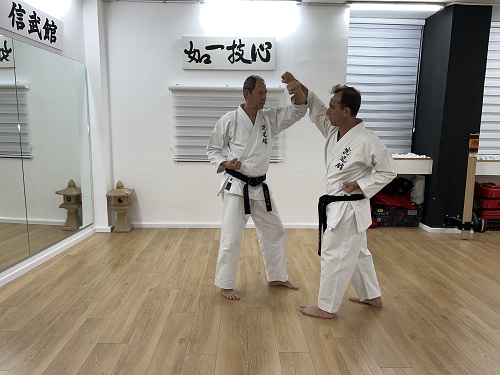
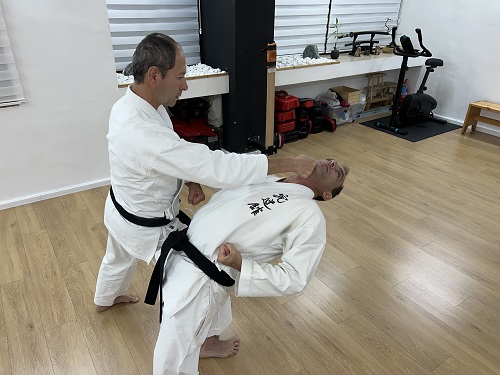
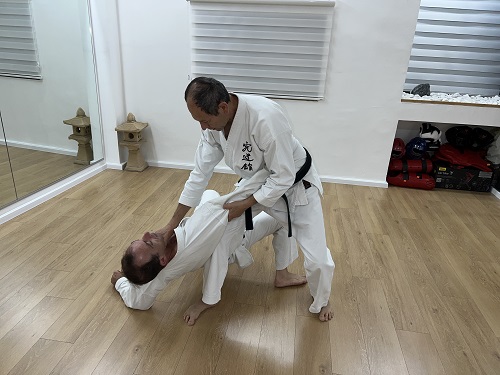
Under any circumstances, we will strive not to change the existing model so as not to lose its value and its relevance to general cases. Since the model is a template, of course we will adjust it for each specific case, this is to move from the theoretical level to the practical one. Yet, we will not change the model but adapt it to the existing situation.
While practicing kata in the dojo, I make a distinction between: Kata, Bunkai, Oyo.
Kata
The kata may be used for technical-motor improvement, body strengthening, coordination, respiratory and other practices. Kata is also important for power production, principles of posture and movement in space as well as flow in movement. Of course, the practice of kata should also be aimed for combat – it this is what we target for. The relevance of kata depends on the practitioner.
Bunkai
The bunkai is a breakdown of kata into its elements, an in-depth analysis of the components and the study and meanings of the technique’s execution. As part of the bunkai, I can assess the technical meanings of a position, a specific movement, or a transition between positions. To develop different ways of acting for a specific movement or technique. The bunkai may be simple or complex and its role is to develop my abilities to understand and perform a technique or a chain of techniques.
Ōyō
The Oyo is the martial or practical combative interpretation of the Bunkai. It must be short, simple, fast and effective. It is the closest product to combat.
Kata 型/形 means pattern, mold or form, shape,
Bunkai means disassembly, dismantling, or analysis.
Ōyō means application or putting into practical use.
Bunkai is designed to explore and deepen knowledge. To find, try and experiment with nuances, to comprehend advantages and disadvantages of each movement, technique. range and angle, and to develop different ways of doing things.
For those aiming at practical combat, it is worthwhile and necessary to delve deeper into bunkai and from there to practice Oyo, that is, the simple and effective operation of the bunkai rationale.
An example of this can be found in the opening of Fukyu-kata-ni / Gekisai-dai-ichi.
Moving from line of attack, keeping the center while taking control of the attacker and neutralizing the threat. The ranges and angles may vary depending on parameters such as attacker’s dimensions, the angle of attack, whether the attack is by fist, an object such as a wooden pole or a knife, etc. We will still carry out the same course of action while adapting to the nuances of the given situation. And these nuances may be significant.
Adjustment to significant change. The attacker holds a knife. A change in ranges and angles and control of the hand holding the knife while neutralizing it immediately.
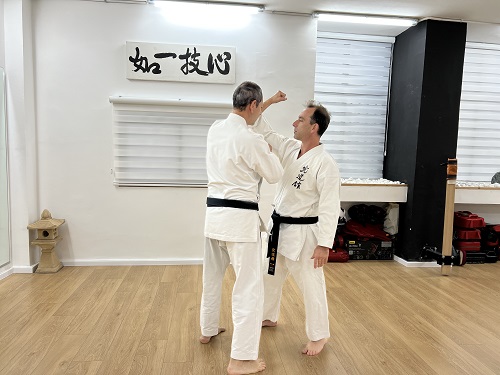
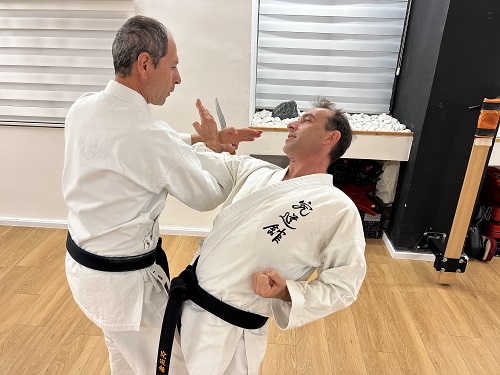
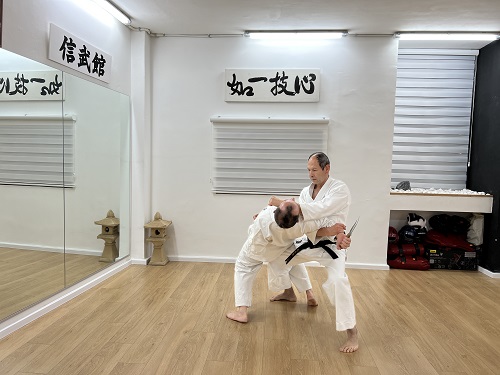
Combat models may expand our tactical range.
Although a cluster of successful tactical battles is insufficient to create strategic success, the opposite is true, A sequence of tactical failures may lead to strategic failure.
The more we delve into the model, i.e., the kata, the more we will be able to discover and comprehend other options that will open. Additionally, we will discover weaknesses and holes that must be filled to adjust to a given situation, so not to be exposed to unnecessary risks or to increase effectiveness.
It is fundamental to implement the model faithfully, and important to implement the model comprehensively and accurately, both at the systemic level and at the individual level. To succeed in this, the practitioner must be guided. Without Sensei’s guidance, the practitioner will not be able to progress and reach an adequate level.
That is why it is so important to practice the kata accurately under the watchful eye of the Sensei, to repeat and practice the kata again and again and to persevere it. This is a long-term process that requires self-discipline and openness.
Military forces also train on models again and again and again. It is important to internalize the model and practice relevant and effective methods of action for the nuances and scenarios that are expected to happen. More than that, internalizing the correct response and performing at a high level will dramatically increase the capabilities of the soldier/security staff and/or unit while encountering with the development of unexpected situations.
Delegating this to karate, the ability of karate-ka will be in direct proportion to the amount and precision of the exercises or kata.
Aiming to practical combat, we must add to the model, that is, the kata, more components such as exercises with various partners. We must practice on different aspects such as pace of training, different intensities, sporadic and instinctive work such as responding to unplanned attacks and different types of combat (soft kumite, Ipon-kumite, high-intensity kumite), dealing with several attackers, with or without various cold weapons, intent of an attacker and the risk potential etc.
Without a kihon (base) that can be equated to the level of soldiers (block/dodge/attack effectively, taking a cover, unloading or assembling weapons, operating a jammed gun, shooting through sights, etc.), and without a kata (model) that combines elements of kihon in different compositions and in different contexts, it will be difficult for a soldier or karate-ka to understand in depth, progress properly and reach to the high level of quality performance.
As mentioned, kata has great value in other areas such as understanding approaches, moves and techniques. Comprehend physiological practice, training and internalizing principles of correct posture and movement, mobility, improving coordination and proprioception, flow in movement while maintaining an accurate base, generating power, and kata is a valuable pedagogical tool. I chose to discuss these areas since they’re outside the scope of this article, although I found it appropriate to mention.
Itzik Cohen
28/07/2023
Recommended literature: Karate’s genetic code
Additional info
Back to Articles List